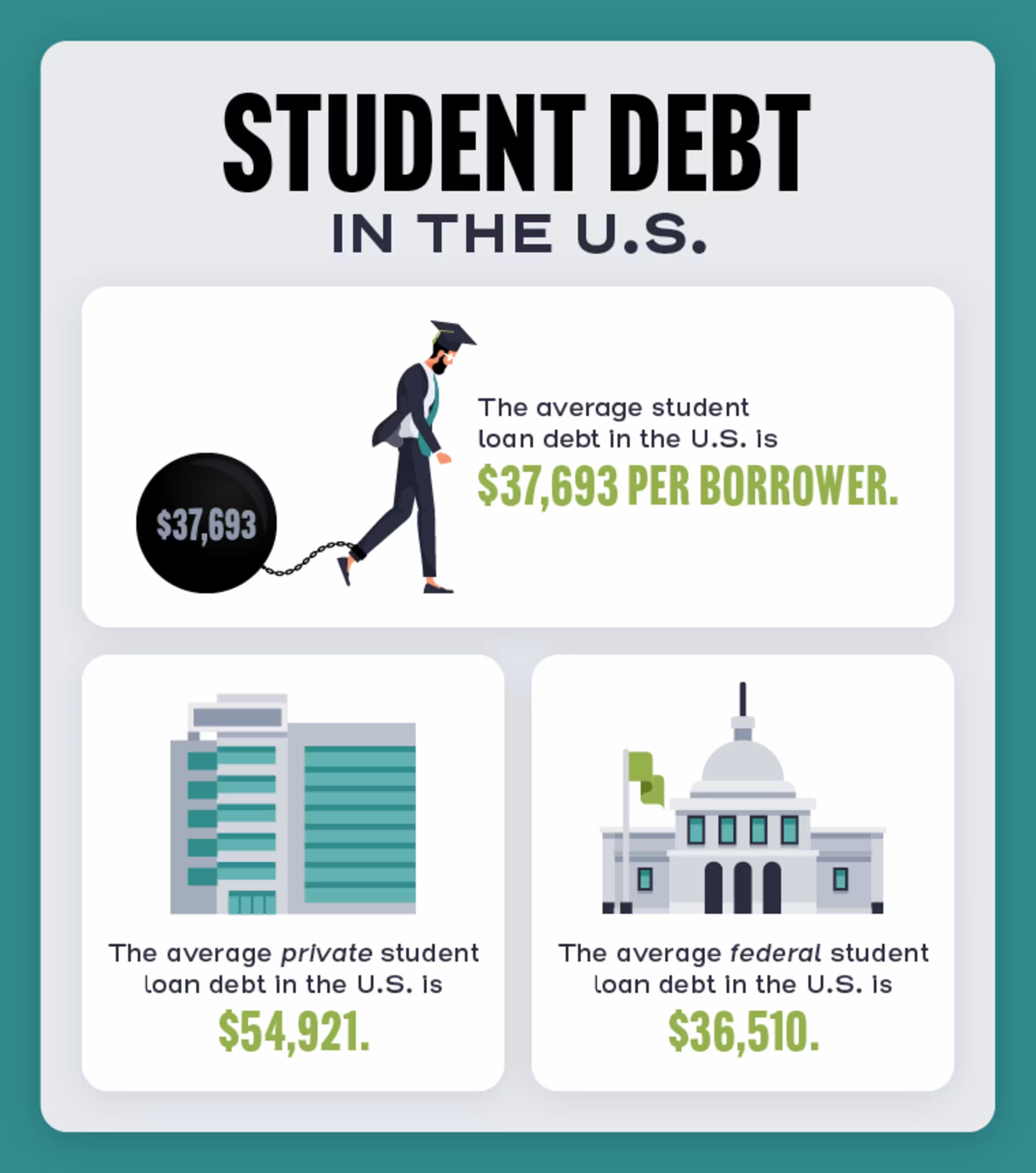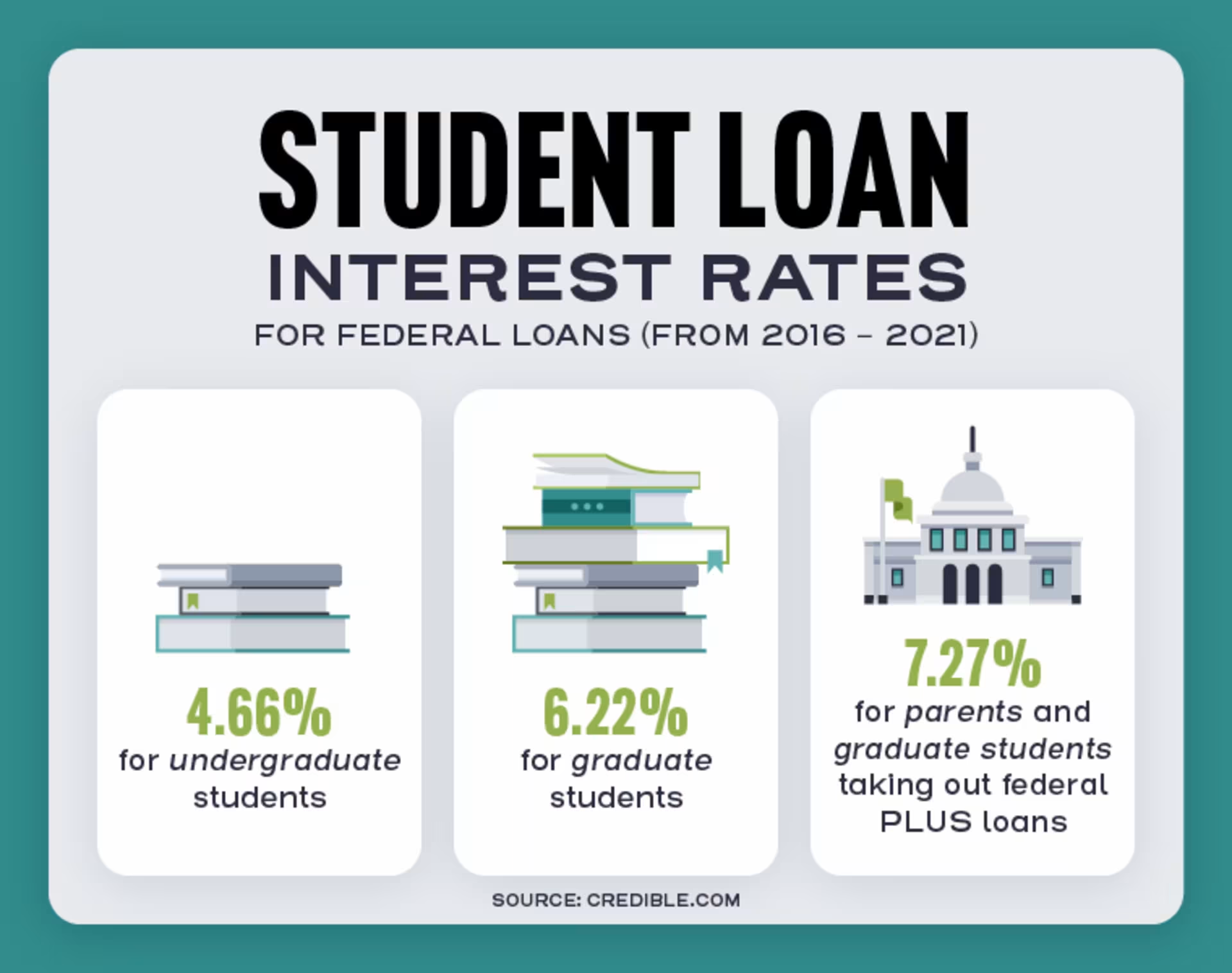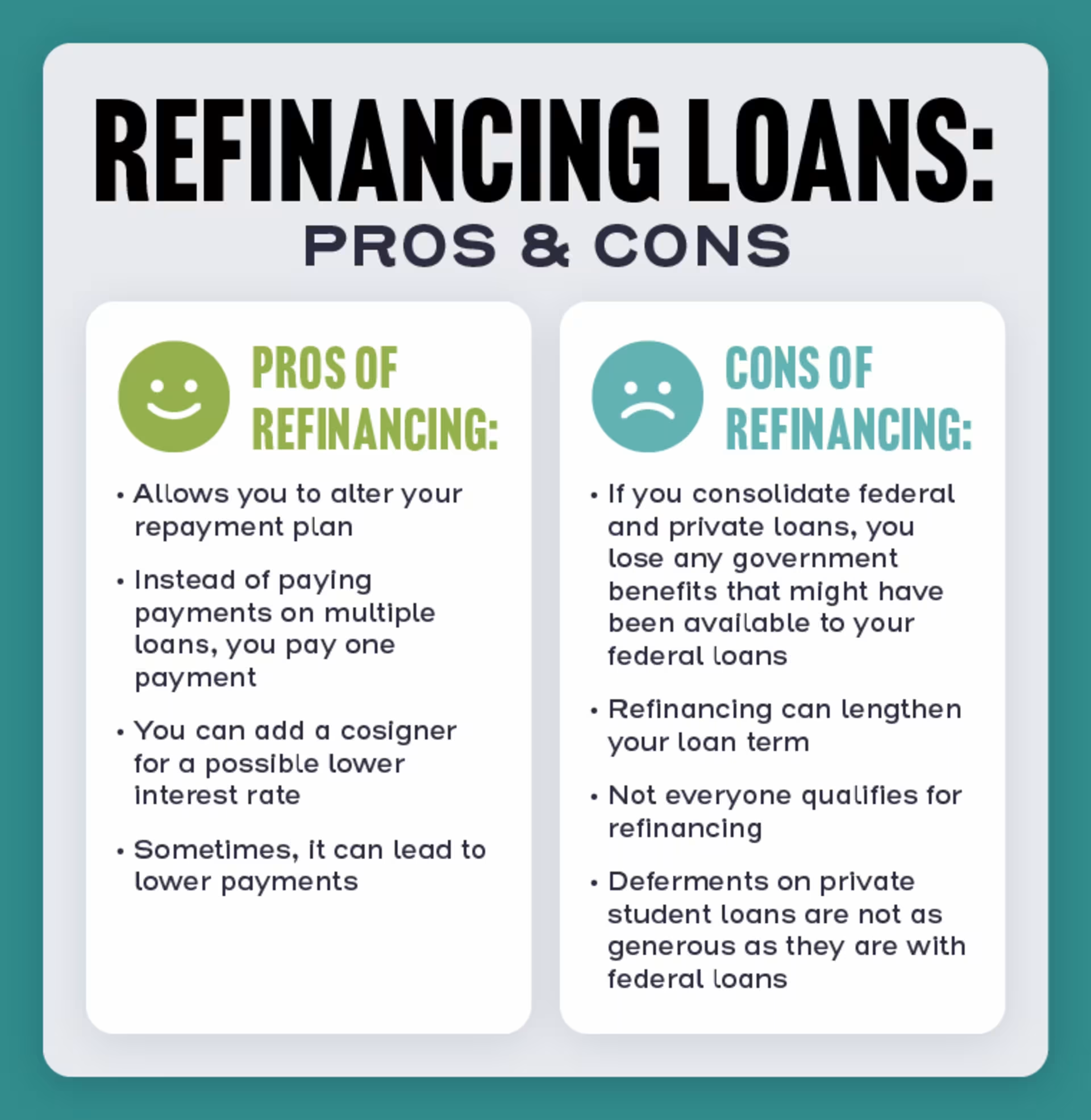Speak with a University Counselor today.
The views and opinions expressed in this article are those of the author’s and do not necessarily reflect the official policy or position of Grand Canyon University. Any sources cited were accurate as of the publish date.
Student loans are something that a lot of college students and college graduates know all too well. The price of a college education isn’t cheap and as years pass students are borrowing more and more money to attend college. In this post we break down everything you need to know about federal and private student loans so you can be knowledgeable about all things student loans.

According to EducationData.org, the average student loan debt in the U.S. is $37,693, as of July 10, 2021. This number changes when you break things down by federal and private loans. The average federal student loan debt is $36,510 per borrower and the average private student loan debt averages $54,921 per borrower.(See disclaimer 1)
According to a survey done by the U.S. News and World Report, college graduates from the class of 2020 who took out student loans borrowed $29,927 on average. That is about $5,000 (20%) more than borrowers from the class of 2010.(See disclaimer 2)
About 45 million borrowers have student loan debt and 95% of them have federal loan debt.(See disclaimer 1) So what exactly is the difference between federal student loans and private student loans?
Federal student loans are loans that are funded by the federal government. The amount of money you get is determined by Cost of Attendance (COA) and financial need. The financial aid staff at your school determines your cost of attendance, then they consider your expected family contribution (EFC). They subtract your expected family contribution from your cost of attendance to determine your financial need and how much need-based aid you can get.
There are a few types of federal student loans.
Private student loans are made by private organizations, such as banks and credit unions and have terms and conditions that are set by the lender. Private student loans can end up being more expensive than federal student loans.
If you're attending school at least part-time, your cost of attendance is calculated by looking at the following items:(See disclaimer 3)
The expected family contribution (EFC) is calculated using a formula created by law. Your family's taxed and untaxed income, assets and benefits (such as unemployment or Social Security) all could be considered in the formula.(See disclaimer 4)

Knowing the interest rate before you commit to a student loan is very important, a high interest rate can result in you paying thousands of extra dollars on your loan in the end. It is important to know that the interest rates for federal student loans are reviewed and may change every July 1. A borrower’s interest rate will be determined and locked in by the first disbursement date.
According to credible.com, the average student loan interest rates for federal student loans from 2006 through 2021 were:(See disclaimer 5)
This same source also lists the interest rate of private student loans for the 2018 year:
Student loan forgiveness, cancellation, or discharge of your loan means that you are no longer required to repay some or all of your loan.
An example of student loan forgiveness or cancellation is when you are no longer required to make payments on your loans based on your job type as stated in the Private Service Loan Forgiveness section below. If you’re no longer required to make payments on your loans due to other circumstances, such as a total and permanent disability, this is called discharge.
There are a few types of forgiveness, cancellation and discharge plans.(See disclaimer **) A few plans are listed below, but please reach out to your loan servicer to see if you qualify for other available plans.
If you are employed by a government or not-for-profit organization, you may be able to receive loan forgiveness under the Public Service Loan Forgiveness (PSLF) Program. PSLF forgives the remaining balance on your Direct Loans after you have made 120 qualifying monthly payments under a qualifying repayment plan while working full-time for a qualifying employer.(See disclaimer 6)
If you teach full-time for five complete and consecutive academic years in a low-income elementary school, secondary school or educational service agency, you may be eligible for forgiveness of up to $17,500 on your Direct Subsidized and Unsubsidized Loans and your Subsidized and Unsubsidized Federal Stafford Loans.(See disclaimer 7)
If you’re totally and permanently disabled, you may qualify for a discharge of your federal student loans and/or Teacher Education Assistance for College and Higher Education (TEACH) Grant service obligation.(See disclaimer 8)
There is a similar option for borrowers with federal student loans, called consolidation. When you consolidate federal loans, otherwise called a Direct Consolidation Loan, the U.S. Department of Education combines all your existing federal student loans into a single loan at no cost to the lender.
The benefit of this is the borrower now has one loan servicer to repay, rather than many, and a new fixed interest rate. Your new rate will be based on the average of the interest rates of the loans being consolidated.
For students who are still attending school, you are advised to work with your loan servicer prior to consolidating your loans, as interest will continue to accrue.
If you think a Direct Consolidation Loan is the best path forward, it’s free, easy to apply and takes about 30 minutes.
According to NerdWallet, in Q2 of 2021 there were 23.2 million federal loan borrowers with loans in forbearance and 3.3 million with loans in deferment.(See disclaimer 11)
For private student loans, Nerdwallet says there are 3.12% of borrowers in forbearance and 19.48% in deferment.
So, what are deferments and forbearance? A forbearance is a temporary postponement of your loan payments and can be used up to 12 months at a time, for a total of 36 months. You can apply for a forbearance verbally by calling your loan servicer, or you can complete a paper forbearance form and submit it to your servicer for processing. Approval for a forbearance is reliant upon servicer discretion. It is also important to know that interest does accrue while on a forbearance.
There is another postponement type, called a deferment, in which you must meet certain qualifications. Unlike a forbearance, interest does not accrue while on a deferment. There are various types of loan deferment plans, including in-school deferment. You are eligible for in-school deferment if you’re enrolled at least half-time at an eligible school. Please contact your loan servicer directly to determine specific regulations, and to see if you qualify.
According to Studentaid.gov, these are the options for repaying your student loans.(See disclaimer 9)
If you have private student loans that you are struggling to repay, refinancing might be a worthwhile consideration. According to Sallie Mae, refinancing occurs when a company buys all your current private student loans and issues you a new loan to pay them all off. You’ll get a new rate and have the option to choose the length of a plan that works for you, but you may lose payment flexibility and special benefits that were available through the individual lenders or the government.(See disclaimer 10)
If you think refinancing is a good option for you, look at multiple lenders and compare loan terms and interest rates before committing.
Pros of Refinancing:
Cons of Refinancing:
A student loan is borrowed money you get from the federal government or a private lender to help pay for college costs.
According to studentaid.gov, to apply for a federal student loan, you must first complete and submit a Free Application for Federal Student Aid (FAFSA®) form. Based on the results of your FAFSA form, your college or career school will send you a financial aid offer, which may include federal student loans. For a private student loan, you can apply through a bank, credit union or online lender. Most private lenders will require borrowers to have good credit and an income to support loan payments. If you don’t meet those qualifications, you’ll need a co-signer who does.
Federal student loan money is sent to the financial aid office at your college or university and private student loan money is sent to either the borrower or the financial aid office. If you have money left over after tuition has been paid, that money will be refunded to the student to pay for any other college-related expenses.
Student loans are borrowed money and must be paid back, while scholarships and grants do not need to be repaid.
According to Saving for College, there are several ways college students can get student loans without a parent borrower or co-signer.(See disclaimer 12) These include:

You can contact your loan servicer and ask about one of the Income Driven Repayment Plans. The servicer will ask questions concerning your annual income, household size and other information to find a repayment plan that best fits your needs. If you are not able to make any payments due to hardship, you may also ask your servicer about deferment or forbearance options as well as other options to temporarily postpone payments until you are able to make payments again. To find out what company services your federal student loans, log into studentaid.gov.
Student loans provide one avenue for funding your education. Another way is through scholarships and grants.(See disclaimer 13) At Grand Canyon University (GCU), we offer generous scholarship opportunities to help make funding a private education affordable. Learn about the various ways to pay for college and discover which resource is best for you.
(See disclaimer *)According to studentaid.gov, non-need-based aid is financial aid that is not based on your expected family contribution. What matters is your cost of attendance and how much other assistance you’ve been awarded so far. For instance, if your cost of attendance is $16,000 and you’ve been awarded a total of $4,000 in need-based aid and private scholarships, you can get up to $12,000 in non-need-based aid.3 There are, however, borrowing limits for federal student loans, so not all your unmet financial need may be covered.
(See disclaimer **)Student loan forgiveness plans are subject to change based on Department of Education regulations.
Retrieved from:
(See disclaimer 1) EducationData.org, Average Student Loan Debt in July 2021
(See disclaimer 2) U.S. News & World Report, See 10 Years of Average Total Student Loan Debt in Sept. 2021
(See disclaimer 3) Federal Student Aid, Wondering How the Amount of Your Federal Student Aid Is Determined? in Sept. 2021
(See disclaimer 4)The EFC Formula 2021-2022 in Sept. 2021
(See disclaimer 5) Credible.com, Average Student Loan Interest Rates in 2021 in Oct. 2021
(See disclaimer 6) Federal Student Aid, Public Service Loan Forgiveness (PSLF) in Sept. 2021
(See disclaimer 7) Federal Student Aid, Wondering Whether You Can Get your Federal Student Loans Forgiven for Your Service as a Teacher? in Sept. 2021
(See disclaimer 8) Federal Student Aid, Total and Permanent Disability Discharge in Sept. 2021
(See disclaimer 9) Federal Student Aid, Choose the Federal Student Loan Repayment Plan That’s Best for You in Sept. 2021
(See disclaimer 10) Sallie Mae, Refinancing Your Student Loans in May 2022
(See disclaimer 11) NerdWallet, Student Loan Debt Statistics: 2021 in Sept. 2021
(See disclaimer 12) Saving for College, How to Get a Student Loan Without Parental Help in Sept. 2021
(See disclaimer 13) Federal Student Aid, What Kinds of Scholarships Are Available? in Sept. 2021
